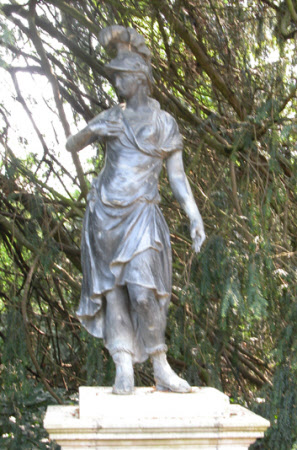Minerva
John Cheere (London 1709 – London 1787)
Category
Art / Sculpture
Date
circa 1750 - circa 1760
Materials
Lead
Measurements
1310 x 510 x 360 mm
Place of origin
London
Order this imageCollection
Anglesey Abbey, Cambridgeshire
NT 515130
Summary
Lead, Minerva, John Cheere (1709-87), mid-18th century. A lead figure of Minerva, the Roman goddess of wisdom, strategic warfare, the arts and trade, cast by John Cheere, London. A life-size figure of a woman standing in contrapposto with proper left leg leading, looking to proper right. Her proper right hand held to her breast, her proper left arm resting (would have once held a spear in hand, now lost). The figure wearing a moulded helmet with plumage, an armoured breast plate under cloth draped and twisted into a mantle and skirts, and Roman sandals. Mounted on stone pedestal.
Full description
John Cheere is known to have supplied casts of Minerva from at least 1755, when a version of the goddess, in a pair with Mars, was sent to Portugal as part of the vast commission for the palace at Queluz (see Neto and Grilo 2006 for a full account). A price list in Lisbon’s Arquivo Torre do Tombo shows that the Cheere workshop was manufacturing two types of Minerva by 1755: one life-size figure priced at £20.0.0 (of which this version at Anglesey Abbey is presumably an example), and one in a pair with Mars adapted from early 18th-century moulds by John Nost II (an example in the collection of the Viscount Weymouth, Longleat, recently for sale). The pair, available at a reduced size and priced at £8.8.0 per figure, were eventually sent to Queluz as part of a mammoth consignment of nine sculptural groups, 57 individual figures and 72 vases. Minerva and Mars are among the surviving Cheere casts at Queluz which can still be seen today. Another cast of the Anglesey-Abbey-type Minerva was formerly at Hamptworth Lodge, Salisbury, and was sold by the garden ornament dealers Architectural Heritage (stock no. 13525/GSO). Later, neoclassical iterations of Cheere’s Minerva produced from the 1760s can be seen at Stourhead (NT 562885) and at Southill Park (Courtauld Institute of Art Photographic Survey, B60/1103). Further examples of lead statuary by John Cheere at Anglesey Abbey are the Lion and Lioness (NT 515157-515158), the Shepherd and Shepherdess (NT 515120-515121), Diana and Apollo (NT 515159-515160, identical to the pair at Queluz), the Grecian sphinxes (NT 515156.1 and 515156.2), The Olympian Courtship (NT 515135, identical to the group at Queluz), and Samson slaying the Philistine (NT 515133). Alice Rylance-Watson 2019
Provenance
Bequeathed to the National Trust by Huttleston Rogers Broughton, 1st Lord Fairhaven (1896-1966) with the house and the rest of the contents.
Credit line
Anglesey Abbey, The Fairhaven Collection (The National Trust)
Makers and roles
John Cheere (London 1709 – London 1787), sculptor
References
Neto and Grilo 2006: Maria João Neto and Fernando Grilo, 'John Cheere's lead garden statues workshop and the important commissions of Prince Pedro of Portugal in 1755-56', Sculpture Journal, vol. 15.1 (2006), pp. 5-18. Fulton 2003: Moira Fulton, ‘John Cheere, the eminent statuary, his workshop and practice, 1737-1787, Sculpture Journal, X, 2003, pp. 21-39. Roper 1964: Lanning Roper, The Gardens of Anglesey Abbey, Cambridgeshire. The Home of Lord Fairhaven, London 1964, p. 62, pl. 39. Christie, Manson & Woods 1971: The National Trust, Anglesey Abbey, Cambridge. Inventory: Furniture, Textiles, Porcelain, Bronzes, Sculpture and Garden Ornaments’, 1971, p. 161.

